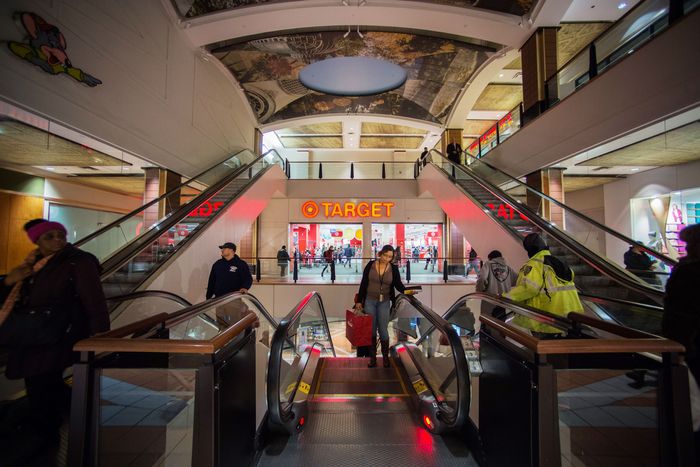
“I feel like a creep,” Asanai Grim tells me after asking a woman on her way into Atlantic Terminal to show her ID. She had stared at him in confusion, surprised to encounter what is essentially a bouncer outside the Bath & Body Works. Grim, one of two security guards stationed at the Flatbush Avenue entrance, isn’t much older than the teenagers he’s required to turn away in their pursuit of Cold Stone Creamery.
The chaperone policy at Atlantic Terminal, which requires anyone under the age of 18 to be accompanied by an adult during most business hours, is just one of several overlapping age restrictions that currently exist at the mall, which sits atop of one of the busiest transit hubs in Brooklyn. Target instituted its own policy a few months back, banning solo teens outright Monday to Friday. The McDonald’s on the ground floor takes a more understated approach to age control by closing its dining area on weekdays during most of the hours high-schoolers are out of school. I asked the manager, Guirlene Joseph, if teens caused issues there. She shrugged. “They come and they don’t want to leave,” she said, hustling finished orders to the counter. Was there anything else? “Not really.” Most people I spoke to said the same. Annoying? Yes. Criminal? No. Teenagers aren’t “any more destructive than anyone else who comes in,” one Target employee told me. “Some do act crazy, like smoking a whole blunt upstairs, but a lot of times, they just want to charge their phone or meet up with their friends.”
So why go to so much trouble to keep them out? Especially in recent months, during which employees and guards say there’s been a big push to ramp up enforcement. Target didn’t respond to multiple requests for comment on its policy, and a spokesperson for Madison International Realty, the owner of Atlantic Terminal, wrote in a statement that its ban was created to institute “a safer environment” after “several incidents involving minors who were not accompanied by an adult resulting in the need for multiple police precinct responses.” It didn’t respond when I asked for specifics — the NYPD wouldn’t provide any, either — and the most recent incidents covered in the media all seem to be from nearly a decade ago. I even asked Crystal Hudson, the city councilmember, if she knew of any recent issues that might justify such a blanket policy. She didn’t. She hadn’t even realized there was a ban. “I don’t know that barring kids is the answer,” she said.
Chaperone policies like this are not new — the Mall of America was among the first to institute one in 1996 (at the time, a spokesperson complained that the mall “had essentially become a babysitter”) — and a different, less restrictive teen ban also existed at Atlantic Terminal under previous ownership. But in the last few years, dozens of new bans have popped up across the country — there’s even a TikTok movement calling for a teen ban at Sephora (other customers complain they’re being surly and buying up all the Drunk Elephant). The reasons given run along the lines of rowdy behavior and the comfort of other shoppers. But, really, they reflect our current mess of anxieties: the national retail panic over shoplifting shuttering the chain pharmacies that we hated a few years ago, fears about teens and TikTok, fears about teens in general (they’re never like they used to be), and some deep-seated discomfort about public and quasi-public spaces that set in during the pandemic and refused to go away.
All of which is a lot more obvious in New York, where we’re used to seeing teenagers moving freely through the city. And where teens are used to it, too, because it’s one of the few places in the country where they can be free — going places here doesn’t depend on access to your parents’ car, like it does pretty much everywhere else. Which is why encountering the ban in real time can feel jarring.
“This guy came up to us and said he was a detective,” a girl who had been kicked out of the DSW in the basement level of Atlantic Terminal told me. “He startled us.” She was part of a group of 11th-graders who’d come to the mall with their social-studies teachers to get something to eat before heading to an event on HCBUs at the Barclays Center. Their teacher, Rony Enriquez, was baffled by the policy. In theory it was ageist, but in practice such teen bans are also racist. “This is the first time I’ve seen something like this,” he said. “It’s targeting a certain population and I think it’s unfair.” It’s also broad to the point of silliness: When I tried to flag down a girl on her way into Uniqlo, she waved me off. She didn’t have time to talk — she was going to be late for work.
It’s also legally murky, Jake Martinez, a deputy director at the New York Civil Liberties Union, wrote in an email. The state law protects the right to use “places of public accommodation,” which likely applies to Atlantic Terminal, without being discriminated against based on your age. In addition to being likely unlawful, he also called it “unnecessary and dehumanizing.”
But teens are also teens, which means they’re good at getting around rules. It’s also unruly, maybe impossible, to fully enforce. A Target employee said workers aren’t allowed to ask for ID, and the smart kids just lie when asked their age. Target also has the only public bathroom in the mall, he added, and it doesn’t feel right to stop teens who say they need to use it. People even slip past the guards downstairs. I met two of them upstairs by the escalator: Xavier and Justin, both 14, who go to school nearby. They didn’t want to reveal how they got in, but given the mall’s multiple entrances, including the DMV, it likely wasn’t all that hard. Why were they there? Why is anyone? “We’re just lollygagging,” Xavier said.







